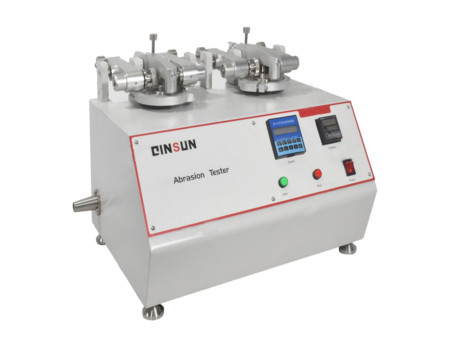-
Test comparison between Martindale and taber abrasion tester
Edited by:Read:Leather abrasion resistance is a characteristic of leather that resists wear and tear. Abrasion of leather is an important cause of damage to leather. Although the wear fastness of leather has not yet been assessed as a *standard*, the abrasion resistance test of leather is still indispensable for measuring its quality and is of great importance in assessing the fastness of leather to wear. According to the test with different instruments, leather abrasion resistance test commonly used methods are mainly two: Martindale flat grinding method and taber abrasion method, Shanghai Qianshui precision mechanical and electrical technology limited company is a textile test instrument manufacturers, can provide a variety of textile testing instruments, welcome customers who have the need to promptly telephone inquiries.
1、Martindale flat abrasion method
Test instrument: Martindale abrasion tester
Martindale flat abrasion method and taber abrasion method test leather wear resistance comparison analysis
Test principle.

The circular specimen in the specimen jig, under the specified load, with Lissajous (Lissajous) graphic plane movement and abrasive (i.e. standard fabric) for friction, the specimen jig can be freely rotated around its axis perpendicular to the horizontal plane, according to the total number of friction of the broken specimen, to determine the abrasion resistance of leather.
Test method.
The test will be a certain size of test sample in the specified pressure and standard abrasive contact with each other, and make the test sample to Lishajou trajectory relative to the abrasive movement, so that the test sample subject to multi-directional uniform wear.
2、Taber abrasion method
Test apparatus: taber wear apparatus tester
Comparative analysis of wear resistance of leather tested by Martindale and taber abrasion methods
Test principle.
Pre-grinding 25 rpm, the specimen to be tested is placed on the horizontal platform of the TABER abrasion testing machine and rotated, two grinding wheels are given a specific pressure to press on the test piece optionally, the axes of the grinding wheels are parallel to the horizontal plane, one grinding wheel facing outwards and the other facing inwards, all changes in the test piece are recorded within a certain period of time.
Test method.
A sample of 108mm outer diameter and 8mm inner diameter is cut with a cutter. A hard sticker of the same size is then applied to the back of the sample. Place the central hole of the sample on the rubber gasket of the screw, put the gasket on and secure the sample with the compression nut. The fixing ring is then put on and the fixing ring screw is locked in place with a spanner. Attach the two H18 grinding wheels to the support arm and apply a force of 250±10g per wheel to the sample being tested, ensuring that the labelled side is facing outwards so that the weight of the wheels is 500g. Set the number of tests according to the standard and set the slewing speed to 72 rpm. Then start the start button, turn on the instrument with a rotation speed of 60±5 times/min, rotate horizontally and carry out the test according to the required number of times. During the test, the brush is used to brush away the surface adherence of the specimen, observe the wear of the test, grind the leather to the specified end point and record the number of revolutions.
From the above two test test methods, the results expressed for the different material wear resistance test methods are not identical. The Martindale flat abrasion method indicates abrasion resistance by the end point and change in appearance, while the taber abrasion method records the number of rubs as an indicator of abrasion resistance.
- 2024-04-19Paper ring compression strength tester standards
- 2024-04-19Cupping tester standards
- 2024-04-19Rubber and plastic tensile tester standards
- 2024-04-19Taber 1750 wear-resistant tester standards
- 2024-04-19Stone Chip Resistance Gravelometer standards
- 2024-04-18Diaper absorption speed tester standards
- 2024-04-18Diaper leakage tester technical indicators
- 2024-04-18Paint film impact resistance tester standards
- 2024-04-18Low temperature brittleness tester principle
- 2024-04-18Battery separator permeability tester technical indicators



